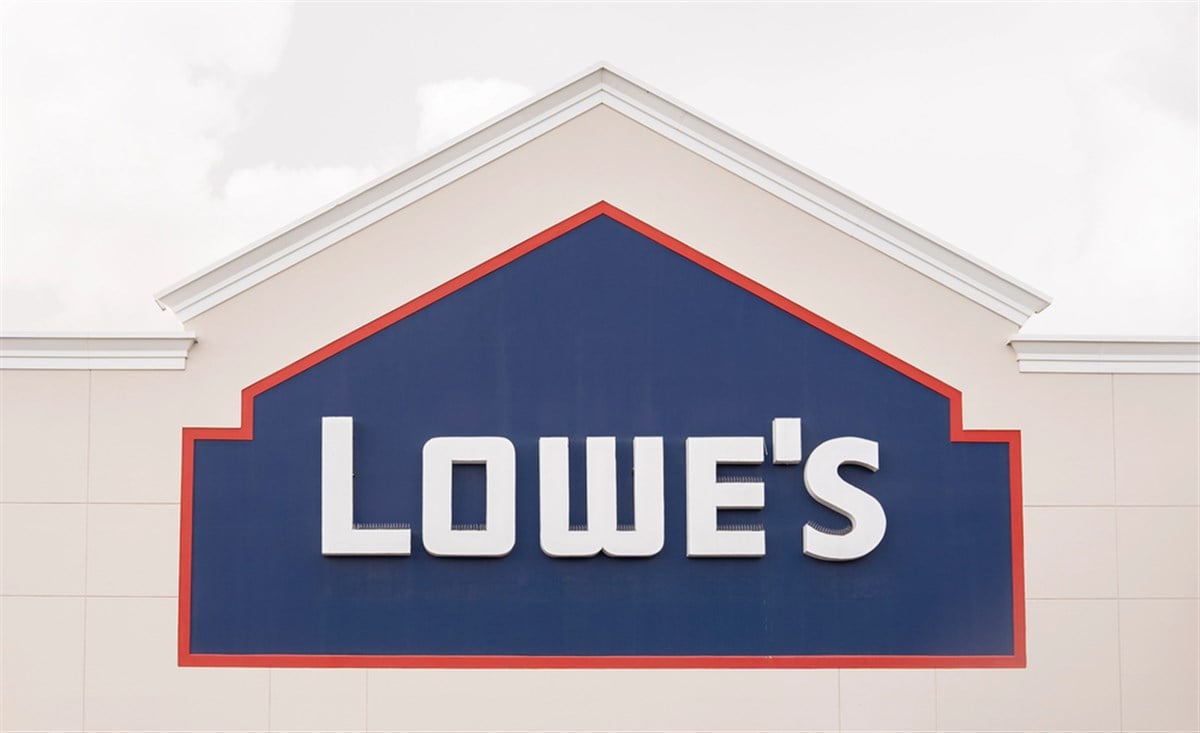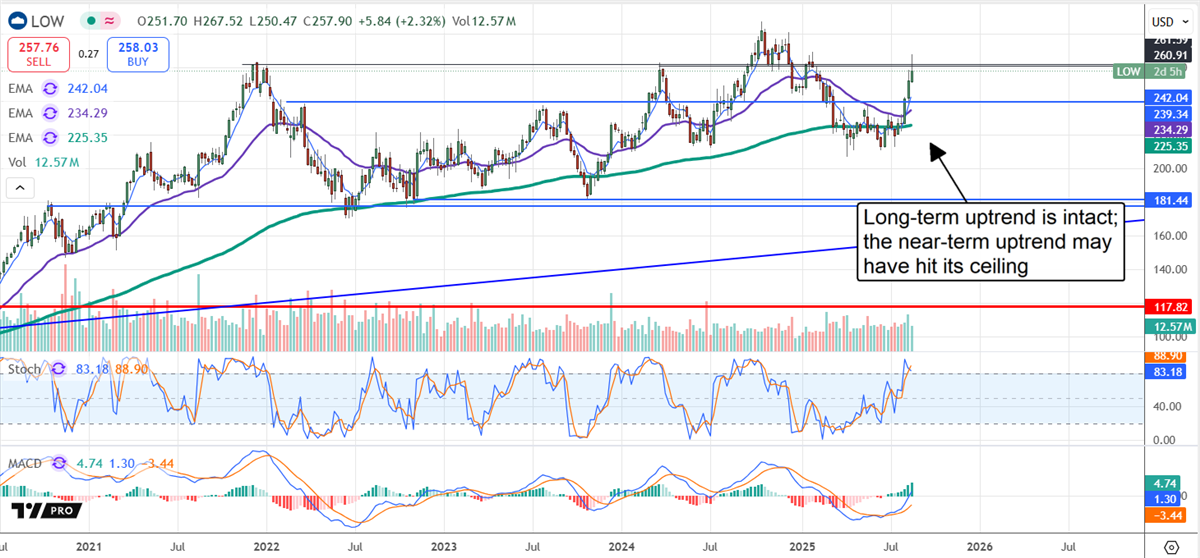| Written by Thomas Hughes 
Lowe’s (NYSE: LOW) FQ2 2026 earnings report proves that it is still a good buy, capable of providing value for investors through capital return and equity gains. The highlights include a beat-and-raise quarter, improved profitability, and new acquisitions that expand its exposure to the Pro market while deepening penetration into the new home market. The takeaway is that this company is growing despite the macroeconomic headwinds and has the financial clout to position itself for the future. The future includes an eventual rebound in the housing market that will consist of existing and new markets driven by demand in DIY and Pro markets. The supply-demand imbalance in housing is well-known. Demand has outstripped supply for over a decade, underpinning the persistent increase in home prices. While housing markets remain stuck in 2025, the FOMC is on track to begin reducing interest rates this year. The caveat is that interest rates are unlikely to fall quickly, and the recovery will take some time to build momentum. The best-case scenario is that housing markets will begin accelerating early-mid-2025; the worst-case scenario is that there is a recession before then. 
Lowe’s Capital Return and Balance Sheet Are Recession-Proof Lowe’s is not exactly a recession-resistant stock, but it has qualities that make it a buy-and-hold stock regardless of economic conditions. Among them are the balance sheet and dividend, which annualize to approximately 1.9% as of mid-August. A dividend by itself isn’t enough to make it a buy, and the almost-2% yield doesn’t mitigate risk; however, the fact that this company is a Dividend Aristocrat and Dividend King with over 60 years of annual distribution increases to its credit does. This company has weathered numerous recessions and economic downturns, including the 2008 Housing Bubble and ensuing Global Financial Crisis, and paid its dividend the entire time. The company also engages in share repurchases, reducing the count significantly over time, which underpins the upward trajectory in the share price action. The company didn’t repurchase any shares in FQ2, choosing instead to invest in new businesses. Still, activity in the preceding 12 months resulted in a 1.5% year-over-year (YOY) reduction in shares, and buybacks will likely be resumed. The critical detail is that Lowe’s reduced its count by more than 25% in the last five years and 45% in the previous ten, and will likely continue to be robust over time. Lowe’s balance sheet is as healthy as it has ever been. The company continues to run a deficit due to the robust share repurchases, but is in a healthy position to continue investing in shareholder value. The Q2 highlights include increased cash, current, and total assets offset by a reduction in long-term debt and total liabilities. The net result was a 17% reduction in the deficit and declining net leverage. Lowe’s Guides for Growth: Analysts Forecast That Lowe’s Growth Will Accelerate The guidance for the remainder of the year is good, certainly better than feared, but it may lead to stock price volatility this fall. The company issued an outlook for revenue that was better than expected, offset by an expectation for slightly narrower margins. The bottom line is that the forecast for adjusted EPS was unchanged, expecting $12.20 at the low end compared to the $12.25 forecasted by MarketBeat’s consensus estimate. That’s good for about 2% YOY growth, and the longer-term forecast is more robust. Long-term estimates, which are likely to be increased due to the acquisitions, forecast revenue and earnings growth to accelerate to the high single-digits over the next few years and sustain a high single-digit pace for several years afterward. Lowe’s price action reflects the strength of the results and outlook as well as the market risks. The stock price surged by several hundred basis points to cross a critical resistance point, only to fall back and confirm resistance. Lowe’s price action may move higher from this level, but there are headwinds. It may also move lower in this scenario, pulling back within its trading range to firmer support levels, possibly as deep as the $220 level.  Read This Story Online Read This Story Online |  |
| Written by Chris Markoch 
August has been a volatile month for stocks as investors try to anticipate the Federal Reserve’s next move on interest rates. That’s why all eyes are on Jackson Hole, Wyoming, this week. On Friday, August 22, Fed Chair Jerome Powell will deliver a speech that often signals longer-term shifts in monetary policy. With markets already pricing in a 25-basis-point cut in September, Powell’s tone is likely to spark short-term volatility. More importantly, the direction Powell signals could determine which sectors lead the market higher, and which lag behind. Jackson Hole: A Historic Venue for Market-Moving Fed Signals The Jackson Hole symposium is an annual event hosted by the Federal Reserve Bank of Kansas City. This is a time when central banks discuss critical global economic issues. It’s also an event that’s known for significant policy signals. For example: - In 2010, Fed chair Ben Bernanke first hinted at the quantitative easing (QE) policy that became the dominant monetary policy for the next dozen years.
- In 2022, Powell introduced the phrase “higher for longer” when discussing the future direction of interest rates.
Normally, the Jackson Hole meeting is an ancillary event for investors. However, this year’s meeting is taking place under a muddled economic backdrop. On the one hand, inflation is moderating but remains above the Fed’s preferred 2% target. Powell has expressed concerns that the Trump administration’s tariff policy will likely fuel inflation, which would only be enhanced by rate cuts. On the other hand, while the “consumer” seems to be holding up, it really depends on which consumer you’re talking about. This is a bifurcated economy, and earnings season is showing that low- to middle-income consumers are under pressure. With that in mind, investors should view this speech as a roadmap rather than a destination. Here are some ideas to consider. What Sectors Benefit If Rate Cuts Look Likely? Lower rates would be bullish for artificial intelligence (AI) stocks as well as other technology stocks and growth stocks in general. Many of these companies sport high valuations. However, they are also pursuing aggressive capital expenditure programs that could benefit from lower discount rates. Another area to consider would be real estate investment trusts (REITs) and utilities stocks. Falling bond yields make their dividends more attractive to income-seeking investors. A third sector to watch would be small-cap stocks. Many of these companies require debt to finance their operations. Lower rates provide better access to capital. What Sectors Benefit If Powell Holds Steady? Don’t fall for the trap that “no cuts” is bearish. Powell’s stated reason for holding the line on rate cuts is the Fed’s belief that the economy is stable and growing. If that’s the case, then there will still be opportunities for investors. These include: - Finance stocks, particularly bank stocks: Higher-for-longer interest rates will improve net interest margins.
- Defensive stocks: This includes sectors like consumer staples and healthcare. Companies with reliable cash flows and strong balance sheets provide shelter during uncertain periods.
Long-Term Investors Should Look Beyond the Noise For retail investors, the key takeaway is not to overreact to headlines. Powell’s Jackson Hole speech will likely move markets in the short term, but those swings are often temporary. The Fed’s policy path evolves over time, and betting portfolios on a single speech is rarely a winning strategy. Instead, long-term investors may want to focus on using volatility as an opportunity, either by adding to high-quality positions during sell-offs or by rotating into sectors aligned with multi-year growth themes. Right now, that means artificial intelligence, the energy transition, or healthcare innovation. Investing in these sectors can be more rewarding than chasing Fed-driven rallies. Ultimately, Powell's speech will provide investors with a roadmap of what is likely to come for the economy. But it’s company fundamentals that drive performance over the long haul.  Read This Story Online Read This Story Online |  This company is the lifeblood of AI data centers, yet almost no one has caught up with the story. Their hardware is so essential that the data center industry uses enough of it to stretch around the world 8 times – in a single building! So, if you own Nvidia stock now, you might be well-served to sell those shares and check out this under-the-radar play instead. Or if you missed the boat on Nvidia, this is a rare second chance to target tremendous profit potential as AI data centers spring up in every corner of the world. Get my full take on this exciting play right here… |
| Written by Ryan Hasson 
Rocket Lab USA (NASDAQ: RKLB) has been one of the standout performers in the space and defense sector this year, steadily climbing higher on the back of strong fundamentals, growing institutional support, and a recent earnings report that appeared to impress Wall Street. Yet with broader markets beginning to flash signs of fatigue, particularly in high-flying tech and growth names, the question for investors is whether RKLB is still on the verge of a significant breakout or if patience might be the better strategy. Market Context: A Risk-Off Shift Hits Growth Stocks This week has highlighted the fragility of risk sentiment in growth-heavy corners of the market. On Tuesday, the Invesco QQQ Trust Series ETF (NASDAQ: QQQ) fell 1.36%, a sharper pullback than the broader market’s 0.5% decline. Leading innovation and growth names like Palantir (NASDAQ: PLTR) and AI Infrastructure darling, Nebius (NASDAQ: NBIS), have seen sharp reversals, with PLTR down nearly 15% over the past week. That shift matters for a name like Rocket Lab, which is also beloved by retail investors. So far, the stock has held up impressively. It remains in a firm uptrend and is currently consolidating in a bullish pattern. But as profit-taking accelerates in other growth leaders, some investors may reconsider chasing breakouts and instead prefer a more disciplined entry strategy. In practical terms, that means keeping an eye on support. If the recent risk-off trend continues, RKLB could test its $40 support level. A break of that threshold might open the door to a move lower toward $35, a level aligned with prior areas of support and consolidation. For investors who have been sitting on the sidelines, such a pullback could offer an attractive entry point rather than paying up after an extended run. Dual Focus on Commercial and Defense Contracts Fuels Outlook While the market’s mood has turned more cautious in the short term, Rocket Lab’s business fundamentals remain encouraging. In its most recent Q2 earnings report, the company delivered revenue of $144.5 million, up 36% year-over-year, representing an increase of almost 18% over Q1. The quarter’s impressive growth was fueled by increased launch activity and continued expansion in satellite manufacturing and components. Equally important, the company continues to execute on its growth initiatives, with a robust pipeline of Electron launches, completion of the Geost acquisition, and progress on its larger Neutron rocket. The dual focus on commercial satellite launches and defense-related contracts gives Rocket Lab a diverse growth runway at a time when demand for space infrastructure is only accelerating. Institutional Support and Analyst Views on Rocket Lab Stock Institutional investors have taken notice. In Q2 alone, $1.03 billion of RKLB shares were purchased by institutions, compared to just $354 million in outflows. That brings institutional ownership to 71.8%, a strong endorsement of confidence in the company’s long-term story. Wall Street analysts also remain constructive. Based on 13 analyst ratings, RKLB holds a consensus Moderate Buy. Interestingly, the average price target now implies about 3.3% upside from current levels. That may not sound like much, but it marks a shift from earlier in the year when the stock price far outpaced analyst estimates. The recent rerating suggests analysts are beginning to catch up to the company’s execution and trajectory. Breakout Potential vs. Patient Entry: What's Next for Rocket Lab? So, is RKLB gearing up for a breakout, or should investors wait? From a technical standpoint, the consolidation pattern remains bullish. If the stock can hold above $40 and sentiment stabilizes, a breakout to new highs would not be surprising, especially with strong institutional backing, relative strength, and continued operational execution. But for those focused on risk management, the more disciplined approach may be to wait for confirmation. If broader growth names continue to sell off, RKLB could test lower support zones, offering a better risk-reward entry. In the context of a new bull market that has already seen many growth stocks double or triple in value, some cooling off is natural and even healthy. Pullbacks allow the train to pull into the station, giving patient investors a chance to board without overpaying.  Read This Story Online Read This Story Online | 
On September 17th, the Fed faces an impossible choice—and Wall Street insiders are already preparing for the fallout. Whether Powell hikes or cuts, both paths lead to wealth destruction for unprepared investors.
American Alternative Assets just released the Mar-A-Lago Accord, revealing how elites are positioning ahead of the decision—and how you can do the same.
Click here to get the free guide and protect your savings before the Fed acts. |
|
0 Response to "🦉 The Night Owl Newsletter for August 20th"
Post a Comment